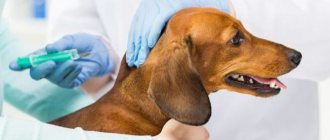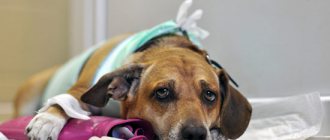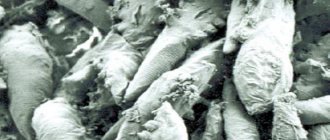Due to the fairly high level of motor activity, injuries in dogs are much more common than in other domestic animals. Moreover, not only large breed animals suffer, but also decorative dogs, which sometimes rarely leave the apartment.
In some cases, the complexity of the injury allows the animal owner to provide emergency assistance himself, ensuring a quick recovery and complete rehabilitation. If the situation is serious, then the best solution would be to consult a veterinarian in a certified clinic. To do this, the owner needs to detect signs of injury in the dog in time and provide it with proper care until a veterinarian takes care of the animal.
Causes of injuries in canines
Dogs are very active animals, and this activity leaves an imprint on their anatomy, physiology and psychology. Representatives of most breeds (with the exception of a number of purely decorative ones) are distinguished by noticeable “strength”, so that often the symptoms of injury in dogs go unnoticed by the owners, and the animal recovers quickly without outside help.
But there are still a number of reasons that can lead to serious damage to the body. Among them:
- Contact with the vehicle. Car injuries to dogs are a phenomenon typical for most cities, especially for such large ones as Moscow. Such injuries are complex and multifaceted, and often end fatally - the animal dies either at the moment of impact or some time after it due to the inability to provide assistance in the required amount.
- Fights. 90% of cases are fights between dogs and representatives of their own species, the remaining 10% occur among cats and birds (a dog’s eye injury is a common result of a “conflict” with jackdaws or crows). During fights, damage can be very different: it all depends on the aggressiveness and weight categories of the participants. Usually the result is damage to the skin, sometimes muscles, accompanied by bleeding of varying degrees of intensity.
- Falls. Falling from a height, from uncomfortable steps, or simply tripping on a slippery surface, animals most often break limbs or suffer concussions.
Features of injury to dogs of large and small breeds
A typical list of reasons why pets can be injured has been described above. But differences in the anatomy and physiology of different breeds also leave their mark on the specifics of injury:
- Large animals - Malamutes, Great Danes, Mastiffs, Newfoundlands and other breeds - are predisposed to limb injuries primarily due to the high load on the joints. Even if an animal stumbles on the stairs, it can suffer a dislocation or sprain simply because the joint receives a short-term load that exceeds its capabilities.
Important! This is one of the reasons why it is necessary to control the body weight of large dogs and provide them with regular physical activity to strengthen the joints and ligaments.
- Medium breed dogs are injured mainly in fights or getting hit by a car. In the first case, there is a direct dependence of the severity of injuries on the breed. “Hierarchical” dogs (for example, huskies) fight actively, but receive almost no serious injuries, while breeds bred for close interaction with humans (Rottweiler, shepherd, large terriers) can actively injure their opponents.
- For small breed dogs, the main threat is... their owners and children. These animals are injured mainly due to a fall from a height: an unsuccessful jump from a sofa or from the owner’s arms leads to a dislocation, fracture or concussion.
In addition, helping small breed dogs with injury is difficult. The small size complicates the immobilization of the limbs, and the small mass creates difficulties for the owners when calculating the dosages of drugs (anaesthetics, painkillers).
The most common causes of injury in dogs
Domestic dogs are distinguished by their activity. Most of the injuries they receive are not serious and pass completely without a trace. The owner of the animal may not even notice that his pet is injured.
But in case of serious damage, the symptoms are quite pronounced and require outside intervention from a veterinarian.
The following factors can cause damage to a dog’s body:
- Road traffic accidents involving an animal. Car collisions are a common cause of injury to dogs in urban environments. A car injury rarely goes away without leaving a trace. As a rule, this is complex damage. Even with timely assistance, it often ends in the death of the pet.
- Brawls with relatives. Fights between dogs are not uncommon. Fights can also occur between dogs and cats or birds. As a result of such collisions, eye injuries in dogs are more often diagnosed. Depending on the aggressiveness of the dog and other active participants in the fight, injuries are observed in the muscle area, accompanied by serious bleeding.
It is important to note that large dog breeds are more likely to suffer limb injuries. This is due to the increased load on their joints and large body weight.
Having carelessly stumbled on the stairs while descending, the dog receives a severe sprain or dislocation. That is why veterinary experts strongly recommend carefully monitoring your pet’s weight by regularly providing physical activity. It is necessary to introduce into the diet drugs that have a strengthening effect on joints and ligaments.
Medium-sized dog breeds are more likely to be injured during fights or as a result of car accidents. But representatives of small and decorative breeds are injured as a result of falls from a height - an unsuccessful jump from the sofa or the owner’s hands. Such seemingly insignificant damage can cause dislocations, fractures or concussions.
Depending on the type of injury and accompanying symptoms, injuries are divided into the following types:
- bruises;
- sprains of the ligamentous apparatus;
- fractures and dislocations;
- bleeding and bruises of internal organs;
- concussions.
The most commonly diagnosed injury in dogs is bruises. Due to the fact that dogs have a high pain threshold, most bruises go unnoticed by the animal owner. But only if the bruise is simple, without severe swelling or crushing of tissue.
Factors that provoke the appearance of a bruise are blows with blunt objects. Characteristic signs of a contusion are bruises and hematomas with slight swelling. Other common injuries in dogs include:
- Stretching. Unlike a bruise, a sprain is manifested by more severe symptoms. Pain occurs when jumping or during active movement. An uncomplicated sprain that goes away on its own.
- A common type of injury in dogs is joint dislocation. The natural position of the articular cartilage surfaces is disrupted. A dislocation in a dog is characterized by swelling and inflammation at the site of the lesion. The animal experiences pain and is also limited in normal movement.
- Fracture. A bone fracture is not accompanied by displacement of bone structures relative to the joint. When fractures occur, the integrity of bone structures is compromised. Fractures in dogs are diagnosed in the hind and fore limbs. In car accidents, the fractures are not single, but multiple.
- Wounds. Wounds sustained by dogs can be bites, lacerations, cuts, punctures or gunshots. The wound is always accompanied by damage to the skin and bleeding. Depending on the extent of the damage, bleeding may or may not be severe.
Dogs receive biting wounds during fights with relatives or cats. Animals receive lacerated wounds during fights with cats and some dogs that have long claws. Lacerations are characterized by extensive damage and bleeding.
Animals receive cut wounds when they come into contact with sharp objects. As a rule, these are glass fragments that a pet steps on while walking. The vast majority of the affected areas are the pads on the pet's paws. The extent of the damage depends on the weight of the animal and the damaging factor.
Less common are stab and gunshot wounds. Puncture wounds have a small entry hole, but the depth of the injury can vary. Wounds resulting from a puncture with a sharp object are diagnosed in the body area, and internal organs can also be damaged.
Gunshot wounds are extremely dangerous. Animals receive them through human intervention. Gunshot wounds from bullets, pellets or pellets can cause serious complications. Especially bleeding, both external and internal.
Bruises
A dog's bruise is a fairly common injury, but rarely noted by owners. This is due to the fact that the animal’s pain threshold is quite high, so bruises without external signs (severe swelling or crushing) go unnoticed under the fur.
A bruise occurs when struck by a blunt object, and is usually accompanied by either the appearance of a bruise or the formation of a subcutaneous swelling (hematoma):
- In the first day after a bruise, it is advisable to limit the spread of swelling by applying cold to the damaged area.
- After 24 hours, minor bruises go away on their own. If the hematoma remains, it is advisable to warm it up (a heating pad, a bandage with heated salt) for 15-20 minutes 3-4 times a day.
- The skin at the site of the bruise is lubricated 2 times a day with special ointments that resolve the hematoma.
Sprains
A sprain, unlike a bruise, occurs when there is awkward movement in a joint. The main symptom is pain during intense movement or jumping, as well as when palpating the problem area. In the absence of ligament rupture, the sprain usually resolves without consequences.
Recommendations for helping with sprains:
- Limiting the animal’s mobility (it’s enough just not to force the dog to run and jump - it takes care of the damaged joint itself).
- Cold on the first day after injury, warm the next 2-3 days.
With such injuries in dogs, treatment in the clinic is not required as often. The exception is situations when bruises accompany more serious injuries (they almost always accompany fractures). It is also worth contacting your veterinarian if the symptoms of sprain do not go away within 3-4 days.
Symptoms of pneumothorax in dogs
Important symptoms that may help you suspect that your dog may have pneumothorax:
- Shortness of breath - frequent shallow breathing, difficulty inhaling and exhaling;
- Sudden dry cough;
- Tachycardia – increased heart rate;
- Weakness and apathy in the dog;
- Feeling of fear - the dog hides, fears being touched;
- A characteristic sign is cyanosis of the mucous membranes and skin, indicating serious respiratory failure;
And also with an open pneumothorax: when you inhale, you will be able to hear a sound reminiscent of a whistle - this is how air will be sucked in through the damaged chest cavity, and back out, foaming the blood released from the wound.
These symptoms make it clear to you that you should contact a specialized veterinary clinic immediately, otherwise the condition of pneumothorax in severe cases and in an advanced state can lead to the death of the dog.
Dislocations
A dislocation is an injury that affects a joint. When a dislocation occurs, the natural position of the articular surfaces is disrupted, and they cannot spontaneously return to their place. Characteristic features:
- Swelling at the joint (swelling and inflammation occur at the site of tissue damage).
- Soreness of the damaged area.
- Restricted mobility in a joint or, conversely, unnatural mobility (the limb bends in a way it shouldn’t).
When a dislocation occurs, it is important to ensure basic immobilization of the animal's limb so that bone displacement does not cause additional damage. After this, the dog should be taken to the clinic as quickly as possible - under no circumstances should you adjust the dislocation yourself. Severe dislocations can be extremely painful, so pain relief for a dog with this type of injury is given quite often - this helps to avoid shock.
Note! It is also undesirable to apply cold to the site of dislocation - cooling the joint can make it difficult to reduce it. Therefore, it is necessary to cool the injury site only for a short period of time, and only if the animal feels severe discomfort.
Fractures
Unlike a dislocation, a fracture is not accompanied by displacement of the bones in the joint, but by a violation of the integrity of the bone. Most often, fractures affect the limbs, but if the cause of the dog’s injury was a car accident, then the animal may receive multiple fractures.
The optimal strategy for a fracture is to deliver the animal to the veterinary clinic as quickly as possible:
- The damaged area is immobilized in order to minimize tissue damage when bone fragments are displaced. For immobilization, thick bandages or splints made from scrap materials are used.
- Open wounds are treated and covered with sterile dressings.
- The fracture site is cooled to reduce pain.
Today, the main method of treating fractures in dogs is osteosynthesis - the installation of metal fixing elements directly into the body of the bone or on its surface. The osteosynthesis operation is performed under general anesthesia, after which the dog must undergo rehabilitation within a month. As a rule, with timely veterinary care, the bones heal well, and the consequences for the animal’s health are minimal.
Wounds and bleeding
A wound is one of the most common injuries in dogs. Most often, this term refers to any injury accompanied by damage to the skin. Bleeding almost always begins when the dog is injured, but sometimes it can appear later - this is typical, for example, of injuries received in a fight with other animals.
According to the type of application and the nature of damage to the skin and tissues, wounds are divided into:
- Biting is a consequence of a fight with another dog or cat.
- Torn - can be obtained in a fight or due to severe damage. They are characterized by significant size, profuse bleeding and tearing off flaps of skin. Injuries to claws in dogs that are excessively long can also be accompanied by lacerations: the claw, acting as a lever, simply tears off the skin and injures blood vessels.
- Cuts - dogs most often get them by stepping on glass or other sharp objects. Accordingly, the paw pads are usually affected, and the extent of the damage directly depends on the dog’s weight.
- Split - characterized by a small area and large depth of penetration. This often happens if the dog runs into a nail or sharp object. Most cases affect the trunk rather than the limbs. The main danger of a puncture wound is hidden damage to internal organs.
- Gunshots are another very dangerous category of wounds. With a gunshot wound, a bullet, shot or buckshot can penetrate deep into the body, causing heavy bleeding - both internal and external.
A wound is not always a reason to visit a veterinarian. The regenerative abilities of dogs are very good, so minor damage to the skin heals either without human intervention or with a little help from the owner.
When processing independently:
- The wound is cleaned of dirt and objects that have gotten into it.
- Torn small fragments of skin are also carefully removed (it is better to do this right away, because the likelihood that a thin flap will take root is small, but it may begin to rot).
- The wound is washed and treated with an antiseptic.
- The edges of the wound are tightened and fixed with a sterile bandage.
- After primary healing has begun, the damaged area is treated with creams and ointments.
If the wound is deep and extensive, there is heavy bleeding or there is a risk of damage to internal organs, you need to take the dog to a veterinarian as soon as possible. In this case, the main task of the owner is to stop bleeding and prevent infection of the wound:
- To stop bleeding, it is necessary to clamp the vessels through which blood flows. This is done manually, using a pressure bandage or tourniquet.
- You can prevent the wound from becoming infected by covering it with a sterile cloth and securing it with a bandage.
If the dog was hit by a car. Interview with a surgeon
April 12, 2016
The life of his pet depends on how correctly and clearly the owner of a dog that has been hit by a car behaves. The surgeon of the Biocontrol clinic, Konstantin Igorevich Eremeev, told what the owner should do and what veterinary surgeons will do in order to save the life and preserve the health of a dog that has received a car injury.
— How should the dog owner behave and what should he do in the first seconds after this misfortune occurs?
“We must remember that an animal, if it is conscious, can bite because it is stressed and in pain. Even your owner. Therefore, you must approach an injured dog with caution. It's a good idea to have a jacket or something similar ready to cover your dog.
It is necessary to assess the dog’s condition – the presence of bleeding, open fractures, consciousness, breathing.
— It is clear that the injured animal must be taken to a veterinary clinic. What is the best way to do this?
— The injured animal should not be pulled or lifted. If the spine is damaged, this can lead to displacement of the vertebrae and even rupture of the spinal cord. The ideal option is to find a piece of plywood or cardboard and carefully slide it under the dog. For larger dogs, a blanket, blanket or even a jacket that can be used as a hammock or stretcher may be suitable.
— How quickly do you need to deliver a downed dog to the clinic? When can you take your time?
- We must hurry in any case. It doesn't matter whether the animal is conscious or not. There are injuries, the consequences of which will develop progressively, for example, lung injury. With such an injury, pneumothorax may develop, in which the owner may initially not pay attention to shortness of breath, and everything will end in the death of the animal. Or internal bleeding, which, if not immediately detected, can lead to extensive blood loss and also death. Even if the dog got up and walked after being hit by a car, this does not mean that everything worked out.
Of course, the mobile phone of the responsible owner must contain both the number and address of the clinic where he will contact in an emergency. It’s worth taking care of this in advance so as not to waste time figuring out where it’s best to take your pet.
— We brought the animal to the clinic. What will happen to him next?
— The owner must tell the receptionist that his animal was involved in an accident, tell him when it happened and how they assess the animal’s condition. Such animals, as a rule, are accepted without a queue, so as not to waste precious time. An anesthesiologist and a surgeon are invited to visit the patient. First of all, a visual inspection is carried out and the general condition is assessed. Additional diagnostic methods may be required: instrumental (X-ray, ultrasound), laboratory (blood test).
After the assessment, a decision is made on further actions. If the condition is satisfactory, treatment may be prescribed. Additional diagnostics may be planned, for example, if an ultrasound showed injuries to internal organs and their condition needs to be assessed over time. The patient may be admitted to the intensive care unit, where he will receive intensive care to bring him out of shock, or, if it is an emergency situation, such as rupture and acute bleeding, then after a short stabilization the animal will go to the operating room.
— And if it’s a fracture, say, of a paw, does the dog immediately undergo surgery?
— The fact is that in the case of an accident, the injuries are most often combined - not only a fracture, but also a contusion of the lungs, injuries or even ruptures of internal organs. In such cases, the life of the animal is our priority and, first of all, therapy is aimed at relieving symptoms that threaten the patient’s life.
For such an operation as osteosynthesis (connecting bone fragments using fixing structures) there are certain temporary conditions for carrying out: it is advisable to operate on intra-articular or open fractures on the first or second day. If these are closed fractures, that is, not “dirty”, then it is better to do them on the second or third day, when the patient’s condition is assessed as stable and the swelling at the fracture site has subsided. Of course, the decision on the timing of the operation is made only by the doctor.
— How often in your practice has a dog getting hit by a car been accompanied by broken bones?
— Often enough. The most common injuries in road accidents in dogs are fractures of the forearms, femur, and pelvis. A spinal fracture is less common.
— Are osteosynthesis required in all cases of bone fractures?
— Almost all of them. There are some types of pelvic fractures that are not "harvested." This depends on the nature of the fracture and the displacement of the fragments.
— And if you don’t do osteosynthesis on a limb, what will happen?
— In this case, improper fusion of bones may occur, a false joint may be formed, biomechanical disturbances, discomfort or pain when using the limb. A re-fracture may also occur at the site of the previous fracture.
— How is osteosynthesis done?
— There are three types of osteosynthesis: extraosseous, intraosseous and transosseous. Bone osteosynthesis is done with plates that are placed on the bone and connected with screws. With intraosseous osteosynthesis, wires or a pin are inserted inside the intramedullary canal of the bone, and transosseous (extrafocal) osteosynthesis is done according to the Ilizarov apparatus type, when the fragments are fixed with wires from the outside using an external structure - ring arches or hardening cement. Types of osteosynthesis can be combined depending on the complexity of the fracture.
— It is clear that in case of a car injury, the dog should be taken to the clinic where there are good surgeons.
— The result of the operation depends not only on the surgeon, but also on the anesthesiology service. The level of the anesthesiological service of Biocontrol allows performing operations of any degree of complexity. It is especially worth noting that we have special equipment that allows us to perform conduction anesthesia.
— What does this give?
“This gives us the opportunity to anesthetize only the limb on which the operation is planned to be performed. This helps reduce the amount of systemic analgesics administered, which significantly reduces the side effects of drugs on the body.
— How long does the rehabilitation period last after operations with osteosynthesis for fractures?
- Of course, it all depends on the type of injury and the time when assistance was provided. If there was a fracture of one limb, then the animal can fully rely on the rest and gradually, over the course of a month or two, if the injury was fresh, the function of the operated limb will be restored. If the injury was old, then, of course, the process will be longer. The use of physiotherapy and rehabilitation - swimming, treadmill, massage - allows you to restore limb function much faster.
In general, the determining factors influencing recovery are: the age of the animal, its weight, the nature of the fracture and the degree of trauma to soft tissues - muscles, blood vessels and nerves.
— Do all elements of osteosynthesis need to be removed?
— It happens that owners do not want to undergo repeated surgery to remove plates or wires. Sometimes we do not recommend it, for example, if the fusion is not perfect and additional fixation of the bones is necessary. The plates and spokes are made of various metal alloys. This is a special low-reactive material and can be left. But, of course, these implants need to be monitored periodically, clinically and radiologically.
24 comments
Natalya (01/05/2019 at 00:45): So beautiful, but in reality!!! In our Little “Chicago” they will even forget their friends, no matter how sad it is! But our people are even the poorest best people on earth!
Reply | to write a message
Natalya (06.23.2019 at 22:43): I was driving from the dacha. A small dog in a collar was lying down on the edge of the road. It was a Pekingese. I stopped, it seemed to me that she was alive. Came up. Because it seemed to me while driving that she was watching. But she wasn't breathing. And the heart could not be felt. But the dog was warm. Soft. I carefully lifted her up - my tongue was lying on its side, under my head there was a puddle of blood about 10 cm in diameter (not much). The eyes are open. I carefully moved it out of the way. For the owners, I decided that she was dead. And only now did I realize that she might have been unconscious. Why did I just leave her! But neither the heart could be felt nor the breathing. I kept my hand on her chest for a long time. Sorry baby. I'm worried that she could be alive. The tongue was bright, not blue.
Reply | to write a message
Natalya (02.24.2020 at 12:37): Good afternoon! The dog was hit in the rear. She didn’t get up for two hours, she was examined and there were no fractures. But they missed that the back part was swollen, the urine was without blood, but the stool was bloody in places. What to do.
Reply | to write a message
- Biocontrol (02/25/2020 at 09:31): Of course, urgently take it to a veterinary clinic with a good surgical department!
Reply | to write a message
Matvey (08/20/2020 at 04:24): My dog was hit by a car. The blow came to the back right paw. Looks like a fracture. They also hit organs. Internal hemorrhage. We can only get to the veterinary hospital at 8:00. We took her to the regional branch. There she was injected with painkillers. All these procedures were performed at 19:00. Now he feels very bad. The stomach is swollen and breathing heavily. We laid her down so that her hind legs were apart, and we put a cold compress under her stomach. Moaning. She didn't have a second meal. It's 4:23 now. Drinks water. Tell me what to do? Need some advice.
Reply | to write a message
- Biocontrol (08/20/2020 at 1:14 p.m.): Matvey, unfortunately, we do not have the ability to conduct emergency consultations on the website. Our doctors answer questions on the forum () within one to two days. In this situation, without being able to examine your animal, all that can be advised is to take the dog to a veterinary clinic as quickly as possible.
Reply | to write a message
Natalya (10.18.2020 at 14:09): The dog was hit by a car 12 hours ago. There are no fractures. He is in a good mood, actively runs around and even pesters the girl. On the way to the hospital, I looked at everything from side to side while standing by the window. The appetite is normal. There was no opportunity in veterinary hospitals do an ultrasound. Therefore, we are very worried, what if something inside is damaged. And it will make itself felt later.
Reply | to write a message
- Biocontrol (10/19/2020 at 09:33): Natalya, hello! In this case, observe your dog. At the first sign of deterioration, take your dog to the doctor immediately.
Reply | to write a message
Ekaterina (04.11.2020 at 21:18): A car hit a cat. Pulmonary edema for 24 hours. Is there a chance to survive? Doesn't drink or eat. Gets injections in the hospital.
Reply | to write a message
- Biocontrol (11.11.2020 at 12:48): Ekaterina, hello! Of course, it is impossible to make predictions based solely on the fact that he was hit by a car and has pulmonary edema. It is important to take into account the age and health status of the cat, the nature and severity of the injuries received, and the quality and timeliness of the assistance provided.
Reply | to write a message
Lyubov (02.12.2020 at 00:37): Hello, my beloved dog was hit by a car, maybe, but he is in a lot of pain, he can’t stand on his back right leg at all, there is no veterinary clinic in our town, maybe you can tell me something?
Reply | to write a message
- Biocontrol (02.12.2020 at 12:12): Love, hello! The only thing I can suggest is that you need to go to a veterinary clinic. It is necessary to assess the nature of the damage, find out whether there are fractures, whether internal organs are affected, whether there are internal hemorrhages. Only on the basis of examinations can one make predictions and prescribe treatment, both surgical and conservative.
Reply | to write a message
Olga Bogdanova (12/05/2020 at 01:08 pm): Hello, our two-month-old Alabai puppy was hit by a bus, she runs, but hasn’t eaten for two days, and what she drinks, she immediately vomits and goes to the toilet, the smell of course, I’m sorry, of course, but he is terrible, will he live? ((((
Reply | to write a message
- Biocontrol (12/07/2020 at 09:14): Hello, Olga! In order to assess the puppy’s health, it is necessary to examine it and, at a minimum, do an x-ray and ultrasound. Accordingly, it is necessary to show the puppy to a veterinarian
Reply | to write a message
Karina (01/18/2021 at 00:07): Hello, the dog was hit by a car, it was driving very slowly, but the dog flew away because it was running fast (Doberman), it immediately came running to me, it was just scared, there are no signs, it has a good appetite, it plays as always. Didn't whine anything. Could everything have worked out? The blow was to the side
Reply | to write a message
Biocontrol (01/18/2021 at 12:42 pm): Karina, hello! Of course, it could have worked out. Carefully observe your dog, its condition, mood, behavior, and the functioning of natural processes. In case of any deviation, it is better to show it to a specialist.
| to write a message
Oleksin Maria (05.02.2021 at 00:56): Vchora Dog Dog, a car, vidza was in Klinіka a fracture of the paw of a strong blow to the front part, they said to bring the dog with the pile of the paw, brought, and the vetlikar said, in the nyoye of Dikhannya, I was Krachny Check it out until Monday, because everything is good, it’s good to operate, it’s hard to suffer, it’s strong, it’s working











